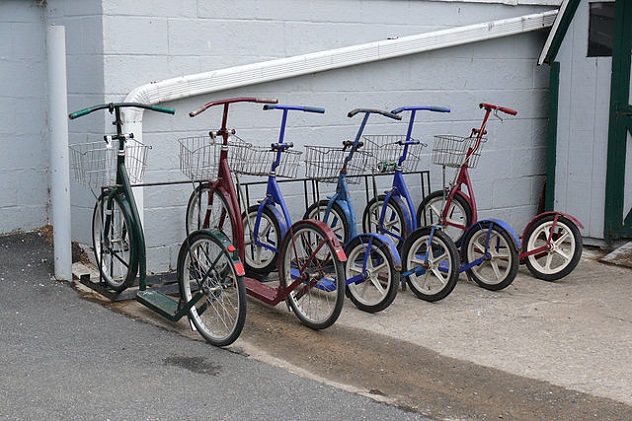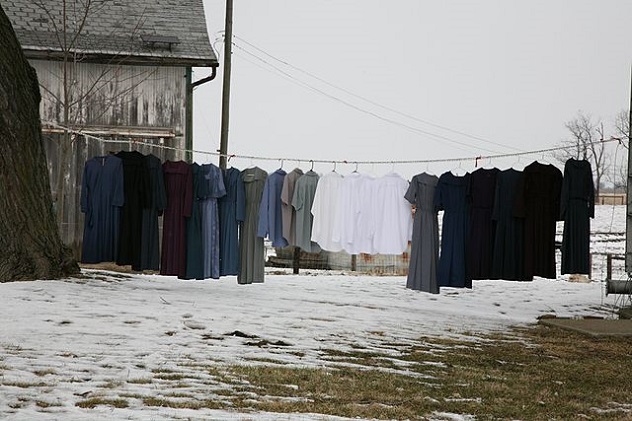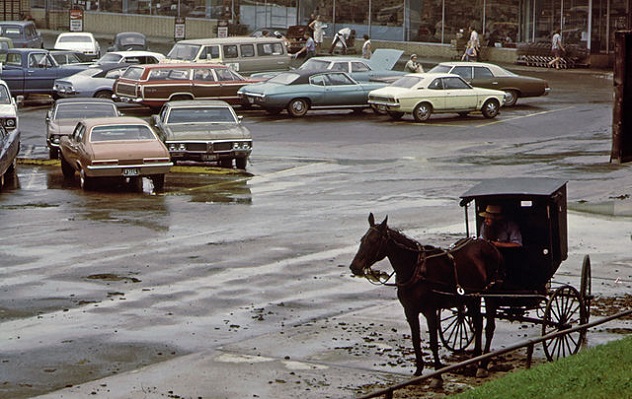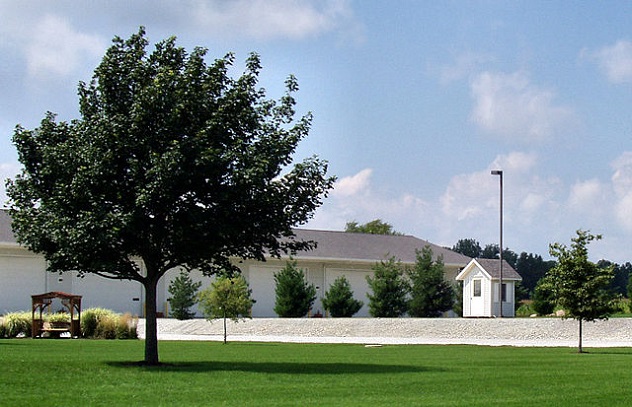 Weird Stuff
Weird Stuff  Weird Stuff
Weird Stuff  Our World
Our World 10 Ways Your Christmas Tree Is More Lit Than You Think
 Movies and TV
Movies and TV The 10 Coolest Stars to Set Sail on The Love Boat
 History
History 10 Things You Didn’t Know About the American National Anthem
 Technology
Technology Top 10 Everyday Tech Buzzwords That Hide a Darker Past
 Humans
Humans 10 Everyday Human Behaviors That Are Actually Survival Instincts
 Animals
Animals 10 Animals That Humiliated and Harmed Historical Leaders
 History
History 10 Most Influential Protests in Modern History
 Creepy
Creepy 10 More Representations of Death from Myth, Legend, and Folktale
 Technology
Technology 10 Scientific Breakthroughs of 2025 That’ll Change Everything
 Weird Stuff
Weird Stuff Ten Bizarre Facts About The Doge Meme
 Our World
Our World 10 Ways Your Christmas Tree Is More Lit Than You Think
 Movies and TV
Movies and TV The 10 Coolest Stars to Set Sail on The Love Boat
Who's Behind Listverse?

Jamie Frater
Head Editor
Jamie founded Listverse due to an insatiable desire to share fascinating, obscure, and bizarre facts. He has been a guest speaker on numerous national radio and television stations and is a five time published author.
More About Us History
History 10 Things You Didn’t Know About the American National Anthem
 Technology
Technology Top 10 Everyday Tech Buzzwords That Hide a Darker Past
 Humans
Humans 10 Everyday Human Behaviors That Are Actually Survival Instincts
 Animals
Animals 10 Animals That Humiliated and Harmed Historical Leaders
 History
History 10 Most Influential Protests in Modern History
 Creepy
Creepy 10 More Representations of Death from Myth, Legend, and Folktale
 Technology
Technology 10 Scientific Breakthroughs of 2025 That’ll Change Everything
10 Modern Luxuries The Amish Actually Use
It’s pretty common knowledge that the hat-donning, mustache-lacking, farm folk known as the Amish actively shun the modern comforts you or I simply couldn’t live without. However, there is more than meets the eye with these humble people, many of whom are actually more modern than you may realize. Though they may opt for the horse-drawn buggy over the convenience of a car, you may be surprised by the cell phones clipped to their belts and the sunglasses shielding their eyes as they cruise down the highways of Pennsylvania.
Try as they might to stave off the modern society, due to certain laws and the almighty power of money, the Amish have had to adapt in order to survive in the cutthroat world of the 21st century. But instead of accepting these new circumstances outright, the Amish have innovatively modified technology so it adheres to their simple ways of life and maintains their separation from modern society. Let’s explore just some of the modern luxuries used by the Amish and how they have welcomed the modern world into their own.
Note: It is worth pointing out that the Amish are not organized under a central leadership structure, and different Amish communities have different rules. Not all communities use all the luxuries described in this list. Statements about “Amish beliefs” refer to the typical or most common traditions.
10 Bikes, Scooters & Roller Blades

Farms are big places, especially when you don’t have a pickup truck or tractor to hop on. So, while walking everywhere will certainly keep you fit, it will also eat up a lot of time—time that could be spent praying, for example. Hence, in most Amish communities, you will see bearded folk zooming about their farms on bicycles. Not all communities are too keen on the use of bikes, though. For example, the Lancaster Amish object to the use of bikes as they “see these as providing too much mobility.” Strangely, they have no issue with scooters. (For clarity, we’re talking about the foot-powered scooters shown above, not the wasp-like Vespas you see all over Europe or on college campuses.)
What’s perhaps even more perplexing is that the Amish also have no real qualms regarding roller blades, an item that most people wouldn’t classify as old-fashioned. However, the Amish simply see this as a form of non-motorized transportation. After all, ice skating has been a popular pastime for hundreds of years, and rollerblading is essentially ice skating with wheels. Who knows, maybe one day the Amish will be competing in the X-games.
9 Washing Machines

Like the kettle and the blender, the washing machine is a chronically underrated appliance that turns an arduous, day-long endeavor into a few simple button pushes. Though most of today’s washing machines require a pretty healthy amount of electricity, some can be powered using a diesel generator. This means the off-the-grid Amish are free to use them. However, those used by the Amish are not the whirring white monoliths with a million dials strewn across the top. They are essentially an electrified version of the postwar-era wringer washers.
While the washing part of the laundry chore may have been made infinitely easier and far more time-efficient, a tumble dryer is simply out of the question for the Amish. Instead they choose to dry their wet garments via the tried-and-true method of hanging them out to dry on a long line and praying it doesn’t rain. When their clothes are eventually dry, they iron them with a traditional, stove-heated iron.
8 Refrigerators

You would think that the Amish wouldn’t really have much use for a fridge, but in 1969, the milk companies required the Amish to cool their milk in large, refrigerated bulk tanks rather than their rustic milk cans. To resolve this power dilemma, the Bishops of Lancaster Amish allowed these bulk tanks to have refrigeration units. The caveat was that they were required to be powered by off-grid methods such as gas or diesel engines.
Today, gas-powered fridges are commonplace within most Amish communities, some even going as far to manufacture their own. (If you like them, you can actually buy one for yourself.) You may well question why they allow a gas-powered fridge but not an electric one, though the answer is remarkably simple. With electrical grid comes a connection and dependency on the outside world as well as a ton of other modern influences such as TV and the Internet. By keeping things simple and gas-powered, you are keeping the modern world at bay. As one Amishman said “You’ve never seen a bottled gas television set, have you?”
7 Planes, Trains & Automobiles

The Amish are not allowed to own automobiles, and that is a rule they adhere to across all communities. The reason for this is that owning a car is a sign of status and could promote vanity and competition between members of the community. This is very much against the Amish values of modesty and the simple life. However, this doesn’t mean that they are not allowed to use modern transport. They’re free to hop on trains and buses, even hiring taxis if necessary. The use of public transport is reserved for necessary business (including “important social events such as weddings, funerals, barn-raisings, and auctions”), with frivolous trips being highly discouraged.
You may well find a tractor lurking on some Amish farms, but before you point out that it’s essentially a slow-moving car, it should be noted that the tractor will have been modified for strictly off-road use. This is often done by removing the rubber tires and replacing them with metal ones, rendering them completely unusable on paved roads. In most cases, tractors are kept in the barn and are used only as a high-powered source for tasks such as blowing silage to the top of silos or pumping liquid manure.
The Amish flat out prohibit air travel unless a community member requires emergency treatment and needs to be airlifted to a hospital; after all, they’re not monsters.
6 Telephones And Cell Phones

The telephone is certainly one of the most revolutionary inventions we’ve yet witnessed. Most people would agree that the telephone had a role in aggressively pushing the expansion of both technology and humanity. This is why it’s often a tad baffling that the Amish use phones so frequently. When the phone became popular in the early 1900s, the Amish banned them outright. Phones were seen as a direct line to the outside world, and they offered too much convenience. However, in time, the Amish came to realize just how useful (and, in some cases, essential) telephones were. Like their attitude toward cars and public transport, they softened their stance to allow the use of phones, just denying ownership of one.
Should you visit an Amish community, chances are you will find a small hut, not dissimilar to a pay phone, containing the community’s landline. (The small booth pictured above is on the property of a non-Amish farmer who maintains the phone for emergency use by the local Amish.) The phones are mainly for business and emergency use but can also be used to talk to other distant Amish communities and to arrange taxi services. By keeping the phones in their own separate booths, the Amish feel that the barrier between the modern world and their own home is maintained.
There is no denying the presence of cell phones within the Amish communities. Unsurprisingly, they are most popular among the youth, but some adults use them, too. Though not strictly legal in the eyes of the religion, cell phones are a controversial form of communication that has become so widespread among the Amish that it is becoming harder and harder for the leadership to speak out against it.
5 Genetically Modified Crops And Pesticides

Biotechnology and the genetic modification of crops is perhaps the most modern farming technique one could think of, but 550 Amish farmers in Pennsylvania alone grow and harvest genetically modified crops without a second thought. While this may seem a tad hypocritical, Amish scholars argue that “genetically enhanced crops are not inconsistent with the simple life that is central to Amish beliefs” and that these crops “help maintain ties to agriculture, allowing families to work together.”
However, the crops grown are not often used by the Amish and are harvested purely for business purposes. For example, farmer Dan Dienner and his family grew genetically modified, nicotine-free tobacco for Vector Tobacco. The Amish merely see pesticides and GM crops as tools that allow them to keep farming in a way that is both practical and profitable. Just as long as said crops are not harvested using modern machinery, the Amish are free to grow what they like. After all, to quote Dienner, “Amish law doesn’t say anything about growing genetically modified tobacco.”
4 Solar Power

Relying on oil and gas for electricity has a certain stigma to it and is often viewed as an archaic mindset. Thinking green is one of the most progressive stances a person can take, so why do the Amish love this state-of-the-art energy technology? For a start, solar panels keep the Amish off the electricity grid, enhancing their separation from today’s society. As Amish expert Donald Kraybill says, “It’s like tapping into God’s grid instead.”
The Amish use solar power as a necessity rather than as a convenience, largely because it is much safer than the gas-powered systems commonly used in their rural communities. The solar panels are used to power many appliances and utilities, including refrigerators for storing milk. They are also used to charge batteries which are needed for buggy headlights. (The law now requires the presence of electric lights on horse-drawn buggies.)
3Modern Medicine

Though the stance regarding healthcare varies between the different communities, the Amish on the whole have no qualms with the use of modern medicine. These choices often come down to a family’s personal preference. They tend to gravitate toward home remedies such as herbal teas and reflexology, though some will use vaccines and antibiotics. Life-saving operations like bypass surgeries are allowed. Some slightly more “frivolous” procedures like hip replacements are not uncommon within the communities.
Given that nearly all Amish live in the United States, their reliance on the health care system plays a huge part in how they approach medicine. The insanely high insurance premiums and excruciating medical bills discourage most Amish from seeking medical attention, instead turning them to their traditional, more wallet-friendly methods. However, in most life-and-death situations, the Amish bite the bullet and pay for the treatment, often raising the necessary funds through community donations.
2 Magazines And Advertising

Advertising has been around for thousands of years, dating back to the time of the ancient Egyptians. Despite this age-old practice, advertisements have never failed to bring a modern touch to their contexts. Even though printed media has been around for hundreds of years, the notion of simple folk like the Amish putting their feet up at the end of a hard day in the fields only to read a glossy magazine full of adverts seems a bit out of place. However, the Amish use of advertising does make sense.
Since farming is not as profitable as it once was, many of the Amish make a living selling their handmade crafts or services as a carpenters and builders. While they do still have plenty of crops to sell, they need a way to get the word out about their crops, goods, and services. But where do they put these ads?
There are numerous magazines, such as the Lancaster County Business Directory and Just Plain Values, that are aimed at the Amish, all of which contain high-quality, surprisingly modern-looking advertisements. These magazines are not run by the Amish themselves but are made by people with close ties to the communities or who may even have Amish relatives.
1 Computers And The Internet

While the notion of cell phones within Amish communities might seem a tad hypocritical, the use of computers and even the Internet takes the biscuit completely. Like the use of cell phones, computers and the Internet are used strictly for business purposes. Those who use them argue that, in today’s uber-competitive world, they need the Internet to sell their products. In some ways, it is one of the most useful advertising platforms out there.
However, the Amish don’t log on themselves. After all, they don’t have the telecommunication cables in their communities, let alone an electrical grid to power the necessary equipment. Instead, they use middlemen and third parties to create, run, and maintain their websites.
Not only do the Amish dabble in IT with Internet use—some even own computers. However, these are far from what most of us would call a “computer.” Whereas we might purchase a computer based on the latest specifications, the Amish do the opposite and base their PC purchases on a distinct lack of features. The “Classic” is just one type of Amish computer that advertises itself as having “no games and no gimmicks,” just stripped-down technology. It’s essentially a word processor with the very basic functions.
Despite their resistance to change, the modern world is slowly but surely creeping into these humble Amish communities. If you’re in the neighborhood, be sure to check them out before a new wave of techno-Amish take over and the old ways are lost to the ages.
My Name is Andy, and I like to write things. I write reviews for DeadPress.co.uk and 7BitArcade.com as well as dabble in a bit of satire over at Undergroundmgzn.com. I prefer gigs over clubs, whiskey over wine and Christina Hendricks over any woman ever made, ever.








